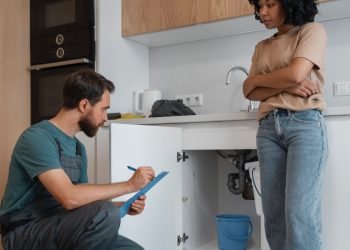
When temperatures drop and winter sets in, frozen pipes quickly become one of the most common household plumbing issues. If left unaddressed, they can lead to costly damages and water disasters. This blog will explore why pipes freeze, how to prevent them, and what to do if you’re dealing with frozen pipe repair. Keep reading to equip yourself with the knowledge to safeguard your plumbing this winter.
Why Do Pipes Freeze?
Pipes freeze when the temperature falls to 32°F (0°C) or lower, especially if they are not well-insulated or are located in unheated areas like basements, attics, crawl spaces, or exterior walls. When water freezes inside a pipe, it expands by about 9%, creating significant pressure. This pressure can cause the pipe to crack or burst, which may result in water leaks and expensive repairs.
Apart from structural damage, frozen pipes often mean you lose access to running water, creating inconvenience in your daily life.
Warning Signs of a Frozen Pipe
Recognizing the signs of a frozen pipe early can save you from a plumbing catastrophe. Look for these indicators:
- Little to no water flow from your faucets.
- Frost or ice forming on exposed pipes.
- Strange clanking or banging noises when you turn on a faucet.
- A foul odor coming from your drains, caused by trapped wastewater.
If you notice any of these signs, act quickly to prevent further damage.
Preventing Pipes from Freezing
Prevention is always easier (and cheaper) than dealing with repairs. Here are some proactive steps to avoid frozen pipes:
Insulate Vulnerable Pipes
Applying pipe insulation to exposed pipes in unheated areas is a simple yet effective preventative measure. Your local plumbing experts can also recommend high-quality insulation materials during pipe installation or retrofitting projects.
Keep Your Home Warm
Maintaining a consistent indoor temperature of at least 55°F (13°C), even when you’re not at home, can protect your pipes from freezing. Open cabinet doors under sinks to allow warm air to circulate around plumbing.
Drip Your Faucets
Allowing faucets to drip slightly during extreme cold helps relieve pressure in the pipe and prevents water from freezing.
Seal Drafts
Inspect your home for drafts near pipes, particularly around windows, doors, and vents. Use caulk or weatherstripping to ensure cold air stays out.
How to Handle Frozen Pipes
Even with the best precautions, sometimes pipes still freeze. If you’re faced with this plumbing emergency, here’s what you can do:
Locate the Frozen Pipe
Identify the affected pipe by checking for frost buildup or areas that feel colder than others. Turn off your main water supply to prevent flooding if the pipe bursts.
Safely Thaw the Pipe
Use a hairdryer, heating pad, or warm towels to gradually thaw the frozen section. Never use an open flame or blowtorch, as this can damage the pipe and create a fire hazard.
Contact a Plumbing Expert
If you cannot locate or thaw the pipe, or if it has already burst, it’s time to call in plumbing experts for frozen pipe repair. Experienced professionals can minimize the damage and restore your water supply quickly.
Why Call Plumbing Experts?
Handling frozen pipes is not a task to take lightly. Licensed plumbing experts not only provide safe and effectivefrozen pipe repair, but they can also offer comprehensive long-term solutions, such as evaluating your home’s plumbing infrastructure and recommending better pipe installation to prevent future issues.
Their expertise and specialized tools ensure repairs are done right the first time, saving you time and money.
Your Action Plan for Winter
Frozen pipes can be a hassle, but they don’t have to turn into a disaster. By taking preventative measures, keeping an eye out for warning signs, and acting promptly when an issue arises, you can minimize the risks and costs associated with frozen pipes.







